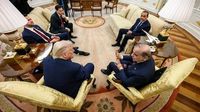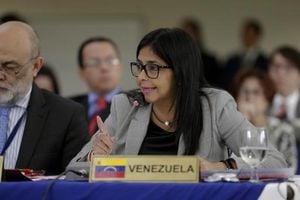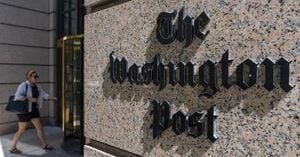On October 8, 2025, the diplomatic world was abuzz as Canadian Prime Minister Mark Carney publicly lauded U.S. President Donald Trump for what he called a “transformative” role in brokering peace between India and Pakistan. The praise, delivered during bilateral talks at the White House, came amid a swirl of competing narratives about who truly orchestrated the recent ceasefire between the two nuclear-armed rivals. As the story unfolded, it exposed not only the complexities of regional diplomacy but also the shifting sands of global alliances, with Pakistan’s re-emergence on the world stage and Trump’s efforts to reshape American influence in South Asia and the Middle East.
“You are a transformative president… the transformation in the economy, unprecedented commitments of NATO partners to defence spending, peace from India, Pakistan through to Azerbaijan, Armenia, disabling Iran as the force of terror,” Carney told Trump in the Oval Office, according to Business Today. The Canadian leader’s effusive praise was echoed by Trump himself, who has repeatedly claimed—almost fifty times since May—that it was Washington’s intervention that led to a “full and immediate” ceasefire between New Delhi and Islamabad after a tense standoff earlier this year.
Trump’s narrative is nothing if not bold. In a video posted by the White House, the president declared, “If I didn’t have the power of tariffs, you would have at least four of the seven wars raging.” He went on to assert that his threat of extreme tariffs not only boosted U.S. revenue but also prevented wars, including what he described as a near-nuclear conflict between India and Pakistan. “The US made hundreds of billions of dollars and acted as a peacekeeper because of tariffs,” Trump said, painting his economic brinkmanship as a cornerstone of global stability.
But the story looks quite different from New Delhi. Indian officials have firmly denied any U.S. mediation in the ceasefire, insisting that the agreement was hammered out directly between the Indian and Pakistani military commanders through their Directors General of Military Operations. Prime Minister Narendra Modi, speaking in Parliament, was unequivocal: “No international leader influenced the decision to halt operations during Operation Sindoor.” According to Indian authorities, the ceasefire was the product of direct, bilateral military dialogue—no outside brokers required.
The competing accounts highlight the perennial tug-of-war over narrative and influence in South Asia. While Trump and his allies tout American intervention as the linchpin of peace, India’s government is keen to assert its autonomy and reject the notion of foreign interference in its security affairs. The result is a diplomatic dance in which each side claims credit for averting disaster, with the truth perhaps lying somewhere in the murky middle.
Meanwhile, the mood in Pakistan has been nothing short of jubilant. As reported by The Friday Times, television anchors and social media users erupted in excitement after images emerged of Trump meeting for nearly 90 minutes at the White House with Pakistan’s Army Chief Field Marshal Asim Munir and Prime Minister Shehbaz Sharif. For many in Pakistan, the meeting represented a long-awaited return to relevance after years of diplomatic isolation and economic hardship. During the Biden administration, Washington’s strategic gaze had shifted firmly toward India, leaving Pakistan feeling sidelined and adrift. Trump’s warmth, therefore, felt like a homecoming of sorts—a chance to reclaim a seat at the global table.
Yet, beneath the surface celebration, there are hard questions about what Trump actually wants from Pakistan. As The Friday Times observed, “America does not give out validation for free.” Trump’s praise for Pakistan’s military—particularly its “air kills” during the recent clash with India—signals what he values: a partner willing to take risks and shoulder burdens where U.S. hands are tied. Two key fronts stand out in Trump’s strategic calculus: the Middle East and Afghanistan.
In the Middle East, Trump is eager to revive the Abraham Accords, his signature initiative aimed at normalizing Israel’s place in the region. The 2023 Gaza war had derailed Saudi-Israeli talks, but recent U.S. strikes on Iran’s nuclear facilities have, in Trump’s view, created an opening for a new security order—one in which Arab states, Israel, and even Muslim militaries like Pakistan’s could play a stabilizing role. Pakistan’s new defense pact with Saudi Arabia has suddenly made it a relevant player in this evolving landscape. Trump reportedly sees Pakistan as a potential contributor to peacekeeping efforts, perhaps even by providing troops to help shore up fragile agreements.
Afghanistan, too, is back on Trump’s radar. He has floated the idea of regaining control of Bagram airbase, a strategic asset, without committing large numbers of American troops. This dovetails with Pakistan’s own frustrations with the Taliban, who continue to harbor the Tehreek-e-Taliban Pakistan (TTP), a group responsible for attacks inside Pakistan. For Trump, this alignment of interests presents an opportunity: Pakistan gets U.S. backing in its fight against militants, while America regains a foothold in a region that remains critical to its security calculus.
For Pakistan’s leaders, the risks of re-engagement are obvious. The Gaza conflict is a quagmire, and Afghanistan has long been a source of instability and sectarian strife. Involvement in either could bring blowback at home—both politically and socially. Yet, after years of isolation and economic struggle, Pakistan’s civilian and military leaders feel they cannot afford to pass up the chance to re-enter the global mainstream. Every photo-op with Trump is seen as a boost to the military’s standing and a shield against domestic criticism. Civilian leaders may grumble about the military’s dominance in foreign policy, but they recognize where the real power lies.
The challenge for Pakistan now is to play its hand wisely. As The Friday Times cautioned, “Saying yes to Trump without conditions could leave Pakistan overexposed in Gaza, mired again in Afghanistan, alienated from Beijing, and once more trapped under military rule at home.” The article warns that history offers a cautionary tale: every time Pakistan has leaned on Washington for validation, it has come at the cost of democratic institutions and increased military dominance.
As the dust settles on a week of high-profile diplomacy, the stakes for all parties remain high. Trump’s efforts to recast himself as a global peacemaker have won him praise from some quarters, but skepticism remains—especially in India. Pakistan, for its part, faces a delicate balancing act: seizing the opportunity to shape regional stability without becoming merely a tool in someone else’s design. The coming months will reveal whether the new chapter in U.S.-Pakistan relations is one of genuine partnership or simply another twist in a long, complicated story.
For now, the world watches as old rivalries and new ambitions collide, with the fate of South Asia—and perhaps the broader region—hanging in the balance.




